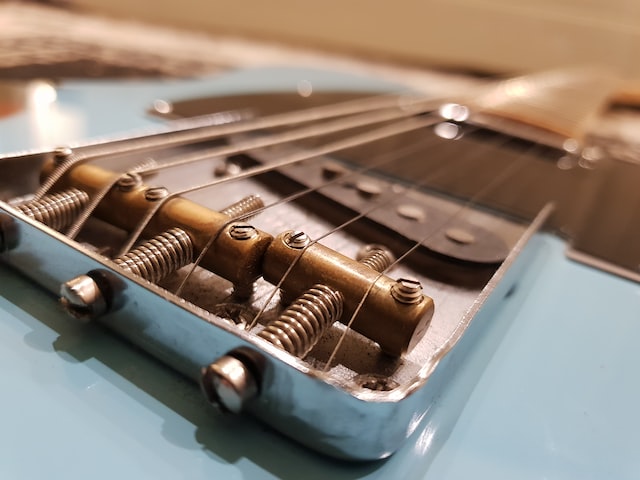
BecomeSingers is reader-supported. When you buy through links on our site, we may earn an affiliate commission. Learn More
Learn how to quickly and easily replace your guitar strings with our step-by-step guide. We’ll show you when you should exactly replace your guitar strings and walk you through the process.
We’ll demonstrate the tools you need, the proper technique, and some handy tips to help you replace them and get the best sound out of your guitar. Whether you’re a beginner or an experienced player, our guide will provide you with everything you need to get your guitar to sound great again.
Our comprehensive guide will spare you the time and money of needing to hire a guitar specialist to replace your strings. We guarantee that you’ll become quite the guitar connoisseur by the time you finish reading this article.
Whether your guitar strings are starting to sound dull and lifeless, or perhaps a string has even snapped mid-performance, there will come a time when you will need to replace your guitar strings. One will eventually break from being old and worn out because they are not built to last forever.
If you frequently play the guitar, you know that you always want to give your instrument a fresh sound. But let’s start by addressing the right question first: when and how you can tell that your guitar strings need to be replaced.
Table of Contents
When Should you Change Your Guitar Strings?
There are a few factors to consider when deciding when to change your guitar strings. You must consider the frequency of use, the type of strings, the tuning of your guitar, the quality of your sound, the color of your strings, and how long you’ve been using them.
Here are a few signs that it might be time to replace your strings:
- Your strings are visibly worn out or frayed. This is often the most obvious sign that it’s time to change your strings. If you can see that the windings are starting to unravel or the strings are frayed, corroded, discolored, or rusting, it’s time to replace them.
- Your strings sound dull or dead. If your strings start losing their bright, lively sound, your guitar isn’t sounding as good as it used to. This can be especially noticeable if you’re playing clean, undistorted tones.
- Your strings are hard to play. If you’re having a hard time pressing down on the strings or they feel slippery under your fingers, it might be time to replace them. This can signify that the strings are starting to wear out or that they’ve picked up a lot of dirt and grime.
- Your guitar doesn’t stay in tune as well as it used to. Old or worn-out strings can stretch more easily and may require frequent tuning.
- Type of strings: Different types of strings will last longer or shorter amounts of time. For example, coated strings tend to last longer than uncoated strings but may not sound as bright.
- You’ve had your strings on for a long time. How often you should change your strings depends on how frequently you play and the type of strings you’re using, but as a general rule, it’s a good idea to change your strings every few months if you’re playing regularly. If you play less often, you can probably get away with changing them every six months or so.
At the end of the day, the best way to know when to change your strings is to pay attention to how they feel and sound. If you start to notice any of the above issues, it’s probably time to replace your strings.
How to Change Your Guitar Strings

Changing the strings on a guitar is a relatively simple process, but it’s important to do it correctly to ensure that your guitar is in good working order. You will need to gather all the necessary tools, such as a new set of strings, a string winder, wire cutters, and a 10mm nut driver.
Here are the steps you can follow to change your guitar strings:
Loosen Old Guitar Strings
To loosen old guitar strings, you need to turn the tuning peg in the opposite direction you would typically turn to tune the string. This will cause the string to become slack, allowing you to remove it from the guitar.
Here are the steps for loosening old guitar strings:
- Begin by selecting the string that you want to remove.
- Locate the tuning peg for that string on the headstock of your guitar.
- Turn the tuning peg counterclockwise using your hand or a string winder. Be careful not to turn the peg too quickly or with too much force, as this can cause the string to snap.
- Continue turning the peg until the string is slack enough to be removed from the guitar.
- Cut the string off at the bridge using wire cutters or a string winder to remove the string quickly.
- Repeat this process for each of the remaining strings on your guitar.
Remove Strings
After loosening up all of your guitar strings, you will need to remove them.
Here are the steps for removing your strings:
- Use your side cutters to lift and pull out your bridge pegs gently.
- After removing all the pegs, take the string out of the bridge by putting tension on it and lifting it right out of the hole.
- By now, you will only have one side of the strings still attached to the headstock.
- Unwind all strings and be careful while removing them, as they may cut you.
You now have all your strings removed.
Check our article on What is the Hardest Instrument to Play?
Clean and Oil the Fretboard (Optional)
Since you already have a naked fretboard, it’s a good idea to clean and oil it, which can help maintain your guitar’s playability and overall condition.
- Wipe down the fretboard. Use a soft cloth or rag to remove any dirt, grime, or sweat accumulated on the fretboard. Be sure to pay extra attention to the areas between the frets.
- If you are using a fretboard cleaner, follow the instructions on the product to apply it to the fretboard.
- Apply the oil. If you are using lemon oil, apply a small amount to a cloth or directly to the fretboard and rub it using circular motions.
- Wipe off the excess oil using a clean cloth or rag. Be sure to remove all of it, as leaving a residue on the fretboard can attract dirt and grime.
Your guitar is now clean, oiled up, and ready to go!
Re-String Your Guitar

Before reinstalling your strings, grab your 10mm nut driver, go over to the top of the tuner post, and use the driver to slightly tighten the capstans (or string posts). Doing so will help the guitar stay tuned when you reinstall your strings.
To re-string your guitar:
- Begin by selecting the string that you want to wind.
- Locate the bridge pin for that string on the bridge of your guitar.
- Carefully insert the end of the string into the hole in the bridge while holding the string in place with one hand and using the other hand to insert the bridge pin. The bridge pin has a small groove that should line up with the string. Once the string is in the groove, gently push the bridge pin back into place.
- The string should sit securely in the hole without slipping out.
- Repeat this process for each string, working from the lowest to the highest string and making sure that all of your strings are installed into the bridge.
Now it’s time to wind the string around the tuning peg.
- Start by grabbing the low E string while keeping a little tension on it and lining it up into the correct string post.
- Start slowly winding the string and making a few wraps around the string post.
- As you wrap the string around the peg, it’s important to keep tension on the string to prevent it from slipping. You can use the restringing tool or your fingers to hold the string in place as you wind it around the peg.
- Continue turning the peg until the string is tightened to the correct tension.
- Repeat this process for each string.
- Cut the excess string using wire cutters as close to the peg as possible.
Stretch and Tune Your Strings
- Determine the standard tuning for your guitar. The standard tuning for a guitar is E-A-D-G-B-E (low to high), although there are many alternate tunings that you can use depending on the type of music you are playing.
- Use a guitar tuner to help you tune your guitar. A guitar tuner is a device that enables you to determine the pitch of each string and adjust it to the correct pitch. There are many types of guitar tuners available, including electronic tuners, clip-on tuners, and smartphone apps.
- Start by tuning the low E string. Play the string and adjust the tuning peg until the string’s pitch matches the reference pitch displayed on the tuner.
- Once the low E string is in tune, move on to the A string. Play the A string and adjust the tuning peg until the string’s pitch matches the reference pitch displayed on the tuner.
- Repeat this process for the remaining strings, working your way up to the highest string. As you tune each string, be sure to check the pitch against the reference pitch displayed on the tuner.
- Once all the strings are in tune, grab each string and give it a light stretch right from the sound hole to the headstock.
- After stretching your strings, you can fine-tune the overall tension of the strings by adjusting the tuning pegs until the strings feel evenly balanced and the guitar is in tune.
- Keep stretching and tuning your strings until your guitar is perfectly tuned.
That’s it! With a little bit of practice, you’ll be able to change your guitar strings quickly and easily. You can try this on your 12 String Acoustic Guitars too.
FAQs
How difficult is it to restring a guitar?
How often should beginners change guitar strings?
Should you wipe your guitar strings?
Should you remove all strings when restringing a guitar?
Conclusion
In conclusion, replacing guitar strings is an important skill to master. It will allow you to keep your guitar in good playing condition and make any necessary string changes to suit your most suitable guitar playing style or music genre. It will also improve your guitar’s sound quality and playability and, most importantly, keep it in tune.
And while it may seem intimidating at first, restringing your guitar is a fairly easy task that most guitarists can learn to do with a bit of practice. We hope that you are now able to replace your guitar strings with confidence and expertise without having to pay a guitar professional to do it for you.
Always refer back to our instructions whenever your guitar needs a new makeover! And have fun with your (relatively) new guitar!





